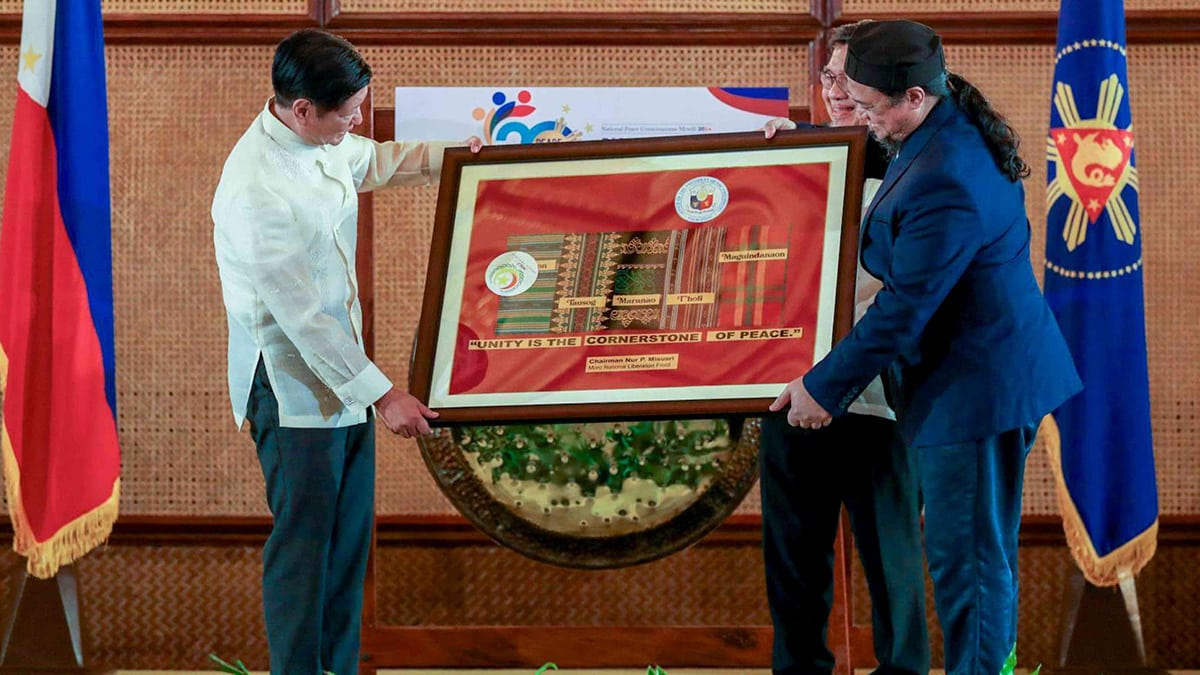Full integration of 7,000 ex-MNLF men pursued

GESTURE OF GRATITUDE Bangsamoro Parliament Deputy Speaker Abdulkarim Tan Misuari (right) hands a souvenir to President Marcos on Monday during a ceremony marking the 28th anniversary of the 1996 Final Peace Agreement forged between the government and MNLF. Partly hidden is Bangsamoro Labor Minister Muslimin Sema. —Presidential Communications Office photo
MANILA, Philippines — Almost three decades after the Moro National Liberation Front (MNLF) dropped their guns and rejoined mainstream society, some 7,000 of its former combatants have yet to be fully transformed as peaceful and productive citizens.
Presidential Peace Adviser Carlito Galvez Jr. said they are now locating these former combatants so they can be covered by the MNLF Transformation Program (MTP).
The move came just as President Marcos vowed on Monday to carry out all signed peace agreements between the government and different revolutionary groups, while pursuing negotiations with the country’s remaining insurgents.
READ: Gov’t, MNLF push for ‘transformation’ of ex-rebels, war-torn villages
“Rest assured that you can depend on this administration to implement all signed peace agreements for the security, inclusive progress and stability not only in Mindanao but throughout [our] country,” said Marcos during the opening of the National Peace Consciousness Month in Malacañang.
Article continues after this advertisementThe event also marked the 28th anniversary of the 1996 Final Peace Agreement (FPA) between the Philippine government and MNLF.
Article continues after this advertisementMarcos, in his speech, noted that the peace processes with former revolutionary organizations such as the Moro Islamic Liberation Front (MILF), Cordillera Bodong Administration-Cordillera People’s Liberation Army, and Rebolusyonaryong Partido ng Manggagawa ng Pilipinas/Revolutionary Proletarian Army/Alex Boncayao Brigade-Tabara Paduano Group, now known as Kapatiran, “are now in the advanced stages of implementation.”
The President credited the efforts of the MNLF and Bangsamoro government, the latter now led by former MILF rebels, in helping solve the armed conflict in Mindanao.
“We would not have progressed this far without your help, [without your] guidance,” said the President.
He said the peace efforts in Mindanao have resulted in increased investments, generated more employment and helped lower poverty incidence in the Bangsamoro Autonomous Region in Muslim Mindanao (BARMM).
Transforming lives
Galvez recalled being reminded by former Executive Secretary Eduardo Ermita, a former soldier who once served as peace negotiator for the government, that at the time when the FPA with the MNLF was forged, the erstwhile separatist group had 14,000 combatants.
Of them, only 7,000 qualified to be integrated into the Armed Forces of the Philippines and Philippine National Police.
So far, the Office of the Presidential Adviser on Peace, Reconciliation and Unity has documented close to 2,000 former combatants mostly in Lanao del Sur and Basilan.
Galvez said they projected to have some 3,000 for Sulu and 2,000 for Maguindanao, Basilan, Tawi-Tawi and Lanao del Sur who will enlist in the MTP, noting that the FPA had provided for a socioeconomic package for those who will not qualify for integration into the country’s security forces.
Those who will enlist will have their firearms stenciled and recorded.
“We are doing this in line with the President’s instruction that no one should be left behind,” said Galvez.
The MTP will hopefully have at least P500 million in funding for next year, he added.
Defining chapter
Last year, the MTP had P294.2 million to support community assessment, socioeconomic profiling of combatants and the implementation of 79 projects for 25 priority communities of the MNLF.
“We appreciate the vow of the President to completely implement all signed agreements. We joined the implementation of the Comprehensive Agreement on the Bangsamoro on this promise. I think our people will see this as a debt of gratitude to the President,” said Bangsamoro Labor Minister Muslimin Sema, who heads a major MNLF faction, referring to the peace pact inked in 2014 by the government and MILF.
The President described the FPA as “a defining chapter in our history.”
“From the forging of the 1976 Tripoli Agreement under my father’s administration, to the signing of the 1996 Final Peace Agreement, we have demonstrated mutual respect and strong collaboration and a burning desire for peace,” he said.
As Marcos lauded the MNLF for helping the government curtail terrorism in Basilan, Sulu and Tawi-Tawi, Galvez noted how the MNLF leaders interceded so that members of the Abu Sayyaf turned their backs on banditry and terrorism.
The President also called on the MNLF and other groups in BARMM to ensure the peaceful and orderly conduct of the first regional parliamentary elections in 2025.
“This landmark, the election of the members of parliament that will occur next year, is as important a landmark as the signing of all of the peace agreements,” he pointed out.
Exploratory talks
With the various peace-building efforts now under way and bearing fruits, Marcos said it was time to “focus on the transformation of our country toward a more inclusive, peaceful and progressive society.”
Galvez said he was confident they would be able to firm up a peace deal with communist rebels “even before the President’s term ends.”
He said “exploratory talks are ongoing” with representatives of the Communist Party of the Philippines-New People’s Army-National Democratic Front even as the government works on “constituency building.”
The process, according to him, is to first come up with a vision statement, then working on a framework agreement that would become the basis for a final peace agreement.